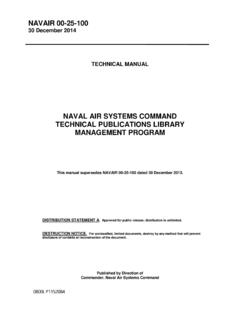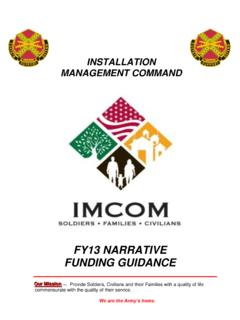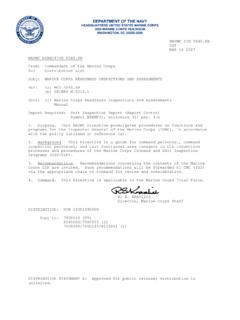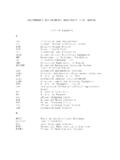Transcription of BY ORDER OF THE COMMANDER AIR FORCE …
1 BY ORDER OF THE COMMANDER AIR FORCE RESERVE command AIR FORCE RESERVE command INSTRUCTION 36-803 2 APRIL 2015 Incorporating Change 1, 24 JUNE 2015 Personnel AIR RESERVE TECHNICIAN TIME AND ATTENDANCE PROCEDURES AND AUDITS COMPLIANCE WITH THIS INSTRUCTION IS MANDATORY ACCESSIBILITY: Publication and forms are available for downloading or ordering on the e-Publishing website at RELEASABILITY: There are no releasability restrictions on this publication OPR: HQ AFRC/A1CE Supersedes: AFRCI36-803, 6 January 2012 Certified by: HQ AFRC/A1 (Col Ellen Moore) Pages: 35 This instruction implements AFPD 36-8, Employee Benefits and Entitlements and Work/Life Programs, by establishing guidelines that implement Time and Attendance procedures and audits for Air Reserve Technicians (ART). It applies to all Air FORCE Reserve command (AFRC) units, functions, and activities. This instruction is not Applicable to the Air National Guard (ANG). Ensure that all records created as a result of processes prescribed in this publication are maintained in accordance with Air FORCE Manual (AFMAN) 33-363, Management of Records, and disposed of in accordance with (IAW) Air FORCE Records Information Management System (AFRIMS) Records Disposition Schedule (RDS).
2 Refer recommended changes and conflicts between this and other publications to the Office of Primary Responsibility (OPR) at HQ AFRC/A1CE, 155 Richard Ray Blvd, Robins AFB GA 31098-1635, on Air FORCE (AF) Form 847, Recommendation for Change of Publication; route AF Form 847s from the field through the appropriate functional chain of command . Submit requests for waivers through the chain of command to the Publication Office of Primary Responsibility (OPR) for non-tiered compliance items. This publication may be supplemented at any level, but all direct Supplements must be routed to the OPR of this publication for coordination prior to certification and approval. SUMMARY OF CHANGES This interim change revises AFRCI36-803 by removing the word worksheet from sentence five and changing the word worksheet to Timecard in sentence seven of section , by replacing (Atch 3) with Management Internal Control Toolset (MICT) in sentence three of , by changing the final sentence in to parallel the referenced paragraph 12, by removing the 3 2 AFRCI36-803 2 APRIL 2015 pay period time limitation for ATAAPS corrections in the second sentence of , and by deleting, per AFI 33-360, , Figure , Time and Attendance Program Checklist.
3 A margin bar (|) indicates newly revised material. 1. Scope of Applicability.. 2 2. Terms and Definitions.. 2 3. Duty Status Definitions.. 3 4. Changes in Duty Status.. 4 5. Duty Status Overseas.. 6 6. Changes in Civilian Tour of Duty.. 7 7. Lunch Periods.. 8 8. Long Distance Flights.. 9 9. Pre-Mission Crew Rest.. 9 10. Constructive Credit hours.. 11 11. Time Spent Traveling and Standby/On-Call Status.. 11 12. Leave Status.. 12 13. Night Differential Entitlement.. 16 14. Time and Attendance and Premium Pay Audit Procedures.. 17 15. Employee Timecard Folder Requirements.. 18 16. Responsibilities: .. 19 17. Military Duty Affecting Timecards.. 22 18. Unit Time and Attendance Audit Product.. 23 19. Work Schedules.. 24 20. Excused Absences.. 25 Attachment 1 GLOSSARY OF REFERENCES AND SUPPORTING INFORMATION 26 Attachment 2 AF FORM 938 CERTIFICATIONS 29 Attachment 3 TIME AND ATTENDANCE 32 Attachment 4 PREMIUM PAY AUDIT TOOL/PROCEDURES FOR UNIT USE 34 1.
4 Scope of Applicability. This instruction applies Air FORCE Reserve command policy to Air Reserve Technicians (ARTs) Title 5 and 10, United States Code. 2. Terms and Definitions. The following terms and definitions are used in this instruction. Administrative Workweek. The Air FORCE administrative workweek begins at 0001 Sunday and ends at 2400 on the next following Saturday. The calendar day on which a shift AFRCI36-803 2 APRIL 2015 3 begins is considered the day of duty for that day even though the day of duty extends into the next calendar day or into the following administrative workweek, reference paragraph , for exceptions. Alternative Work Schedules (AWS). Work schedules made up of flexible or compressed schedules. See paragraph 19 for guidance on alternative work schedules. Alternative Workplace Arrangements (AWA). Working under a flexi-place/telework arrangement, either at home or other approved location(s), such as a telecommuting center.
5 Basic Workweek. The days and hours of an administrative workweek which make up a full-time employee's regularly scheduled 40-hour workweek. Compressed Schedule. Compressed schedule means, for a full-time employee, an 80-hour biweekly basic work requirement which is scheduled in less than 10 workdays. In the case of a part-time employee, it is a biweekly basic work requirement of less than 80 hours which is scheduled for less than 10 workdays. First 40-Hours. An AWS which allows for the first 40 hours of duty performed within a period of no more than six days of the administrative workweek to be established as the basic workweek when it is impractical to prescribe core hours or a regular schedule of definite hours of duty each workday. Flexible Schedule. A Flexible schedule has a portion of the work day during which the employee has the option to select and may have the option to vary starting and stopping times within established limits set by installation level approving officials for AWS.
6 Holiday Work. Work performed on a legal holiday or the day observed as a holiday. In-Lieu-of Day. An in-lieu-of day is a holiday in which employees are given time off on a day other than the date which the holiday actually falls on. Part Time. In some circumstances it is not possible to obtain or use an employee's services for the full 40-hour workweek. Part time tours of duty may be authorized when service on a regular, repetitive basis is required at least one day during each administrative workweek, however, additional service may be required during the remainder of the administrative workweek. Regular Tour of Duty. The regular tour of duty for Air FORCE employees is five 8-hour days, Monday through Friday. Special Tour of Duty for Educational Purposes. A special tour of duty of no less than 40 hours in an administrative workweek which may be established by supervisors to permit employees to take courses at nearby educational institutions.
7 Uncommon Tour of Duty. Any 40-hour basic workweek scheduled to include Saturday and or Sunday, for four workdays or less but not more than six days of the administrative workweek. An uncommon tour of duty may be established when necessary for efficient operations or when the cost of operations can thus be reduced without imposing undue hardship on employees. 3. Duty Status Definitions. 4 AFRCI36-803 2 APRIL 2015 Inactive Duty for Training (IDT). There are five types of IDT for which eligible members may be paid: Training Period (TP) - a period of training, duty, or instruction that a member performs as an individual (includes Additional Ground Training Periods (AGTP)). Unit Training Assembly (UTA) - a planned period of training duty, instruction, or alert performed by a Category A unit. Equivalent Training (EQT) - a training period performed in place of a regularly scheduled UTA or TP missed, due to a member s personal request/convenience.
8 Additional Flying Training Periods (AFTP) - a training period that may be authorized for members who must fly frequently. Readiness Management Period (RMP) - a planned period that is used to accomplish readiness/training requirements that are a minimum of 4 hours in duration. Active Duty for Training (ADT). A tour of active duty for Reserve training under orders, which provides for automatic reversion to non-active duty status when the specific period of active duty is completed. It includes annual training (AT), special tours of active duty for training and school tour (ADT), and active duty for operational support (ADOS), which are funded from the Reserve Personnel Appropriations (RPA) account. Also included are temporary tours of active duty support for active FORCE missions, which are funded from the Military Personnel Appropriation (MPA) account. Travel and Per Diem: Use the Joint Travel Regulation (JTR) and Joint Federal Travel Regulation (JFTR), as applicable, for all specific guidance.
9 Travel in civilian pay and per diem status solely to perform military duty is forbidden as is traveling in military status to perform civilian duty. However, travel in civilian status to perform civilian duty in conjunction with IDT or ADT is acceptable. For example, it is allowed for a member who is TDY in civilian status to perform an IDT while TDY and convert back to civilian status when the IDT is completed. Travel and per diem may not be paid for travel to IDT except under limited circumstances involving duty away from home station. Reimbursement is limited to that authorized by the JTR. 4. Changes in Duty Status. All periods of military duty must be scheduled in advance, meet normal Reserve participation requirements, and be annotated on official orders. Conversion of duty status must be approved by an authority no lower than the orders certifying official.
10 Except as provided below, the duty status in which an ART departs home station will continue until they return. If periods of civilian duty are scheduled in conjunction with IDT flight training, ensure that either the preflight or post flight duties are accomplished in IDT status and that the status matches with the status on the AFTO Form 781, Arms Aircrew/Mission Flight Data Document. Both preflight and post flight duties may be accomplished in IDT status but one or the other must be in IDT status. In-flight duty status conversions to or AFRCI36-803 2 APRIL 2015 5 from IDT status are permitted IAW scheduling documents (AF IMT 40A, AF Form 3956, AF IMT 938, etc.). If one or more IDT periods are scheduled while on Temporary Duty (TDY): Member will convert to IDT and back at times specified on the AF Form(s) 40/40a, Authorization for Inactive Duty Training/Authorization for Individual Inactive Duty Training or other scheduling documents.
















